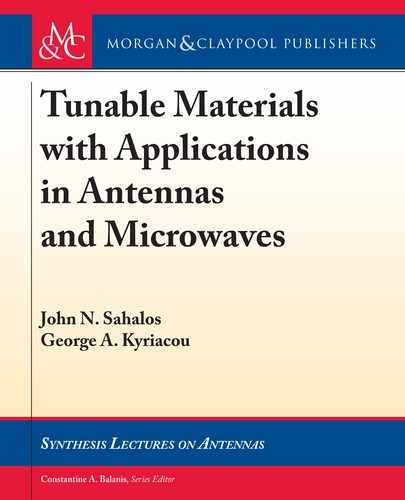2.10. HYSTERESIS LOOP 49
2.10 HYSTERESIS LOOP
e application of an alternating electric field to a ferroelectric material shows that the polariza-
tion traces a hysteresis loop as shown in Figure 2.18. Recall that when an increasing DC electric
field is applied to an unpolarized ferroelectric, the energetically favorable domains (those with
dipoles aligned in the applied field direction) start expanding with the appropriate movement
of the domain walls. In this case, polarization follows the curve OB in Figure 2.18. At point B
and beyond, the whole ferroelectric specimen becomes an almost monodomain crystal where all
dipoles are aligned along the applied field.
A further increase in the field beyond point B and up to a maximum intensity Em, corre-
sponding to the maximum voltage applied to the crystal, causes a linear increase in polarization
along curve BC, which is due only to the mechanisms of induced dipoles (electronic and ionic).
Decreasing the field from Em toward zero causes polarization to follow a reversible part CB
first (the one due solely to induced dipoles), and then the irreversible trace BD. At zero-applied
electric field, point D, the crystal remains monodomain with a remnant polarization P
S
[40].
Changing the sign of the applied field and increasing its intensity toward negative values causes
polarization to follow trace DF; that is, polarization remains positive and decreases slowly from
its remnant value. At some point F, the electric field reaches some critical value (-Ec), called
“the coercive field.” At this point, the regions (domains) with spontaneous polarization parallel
to the (negative) field direction start to expand rapidly. is causes a rapid decrease in polar-
ization, a change of the sign, and an “increase” toward negative values following curve FL. At
point L, the crystal becomes monodomain again and polarization is aligned along the applied
electric field. Similar phenomena occur when the electric field starts to increase either toward
negative or positive values. Finally, an alternating electric field will cause the polarization vector
to follow the hysteresis loop of Figure 2.18. As usual, the area enclosed within the hysteresis
loop represents a loss of energy, known as hysteresis loss. However, the application of a strong
DC electric field in conjunction with a weak RF microwave alternating field will result in the
small area of the hysteresis loop shown in Figure 2.19.
2.11 FERROELECTRIC MATERIALS—PEROVSKITES
e phenomenon of ferroelectricity was discovered by Valasek in 1920 [42] while he was inves-
tigating the anomalous dielectric properties of the Rochelle salt (NaKC
4
O 6 H
2
O). Many dif-
ferent ferroelectric materials have been discovered since that early work. Most of the practically
used ferroelectrics exhibit a so-called “perovskite” crystal structure, which is a corner-sharing
octahedron, presented in Figure 2.20. It may seem strange, but the perovskite crystal structure
is also encountered in some ferrite types [43].

50 2. TUNABLE MATERIALS–CHARACTERISTICS AND CONSTITUTIVE PARAMETERS
Polarization
Electric Field
-Em
+Em+Ec
-Ec
D
F
0
L
-Ps
+Ps
B
C
Figure 2.18: Polarization curves of a ferroelectric crystal and its hysteresis loop when a periodic
electric field is applied.
4
5
6
3
2
1
1
2
3
4
5
6
-Ec
+Ec
+Pr
-Pr
P
E
Figure 2.19: Ferroelectric hysteresis loop under small periodic electric field conditions.
2.12 THE PEROVSKITE CRYSTAL STRUCTURE
e general formula of the perovskite crystal structure is ABX
3
, where A and B are cations
and X is an anion, usually oxygen. For ferroelectrics, it is A D .S r; Ba; Y; Ca; : : :/, B D
.T i; C u; Ru; : : :/ and X D .O; F; : : :/. As shown in Figure 2.20, the A sites are 12-fold co-
ordinated by X atoms (usually X D O oxygen), the B sites are 6-fold co-ordinated, and each X
..................Content has been hidden....................
You can't read the all page of ebook, please click here login for view all page.
